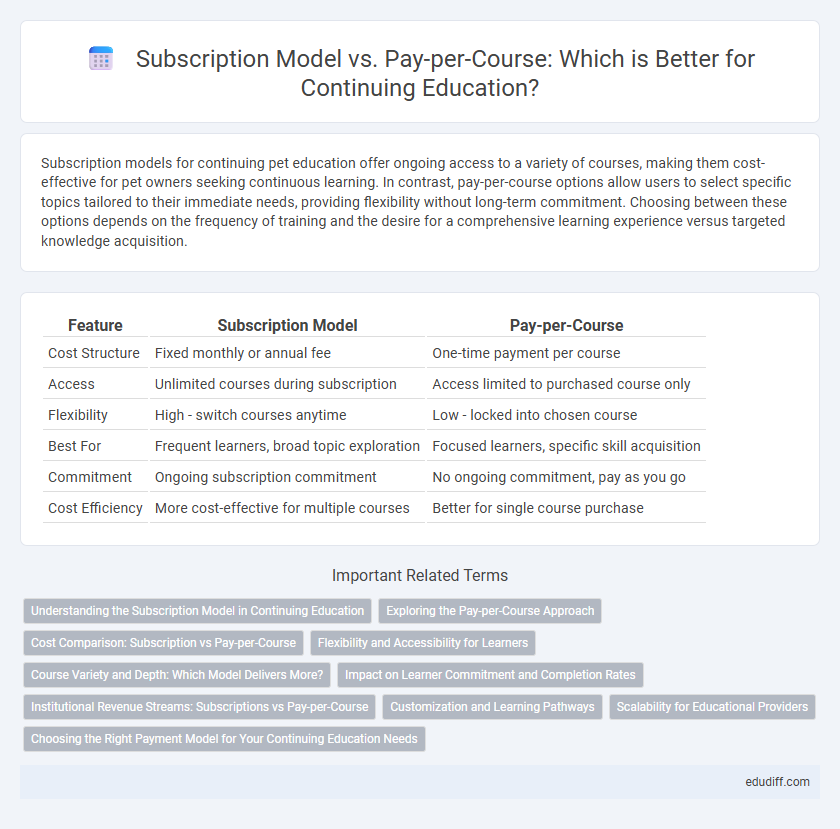Subscription models for continuing pet education offer ongoing access to a variety of courses, making them cost-effective for pet owners seeking continuous learning. In contrast, pay-per-course options allow users to select specific topics tailored to their immediate needs, providing flexibility without long-term commitment. Choosing between these options depends on the frequency of training and the desire for a comprehensive learning experience versus targeted knowledge acquisition.
Table of Comparison
| Feature | Subscription Model | Pay-per-Course |
|---|---|---|
| Cost Structure | Fixed monthly or annual fee | One-time payment per course |
| Access | Unlimited courses during subscription | Access limited to purchased course only |
| Flexibility | High - switch courses anytime | Low - locked into chosen course |
| Best For | Frequent learners, broad topic exploration | Focused learners, specific skill acquisition |
| Commitment | Ongoing subscription commitment | No ongoing commitment, pay as you go |
| Cost Efficiency | More cost-effective for multiple courses | Better for single course purchase |
Understanding the Subscription Model in Continuing Education
The subscription model in continuing education offers learners unlimited access to a wide range of courses for a fixed monthly or annual fee, fostering continuous skill development and flexibility. This model benefits professionals seeking to stay updated with industry trends by providing diverse learning options without the need for multiple individual purchases. The predictable cost structure and seamless access enhance learner engagement and make ongoing education more accessible and convenient.
Exploring the Pay-per-Course Approach
The pay-per-course model allows learners to purchase individual courses tailored to their specific interests, providing flexibility and targeted skill acquisition without ongoing commitments. This approach benefits users who prefer to control their learning expenses and focus on immediate educational goals. Institutions can leverage pay-per-course pricing to attract a diverse range of customers seeking specialized knowledge.
Cost Comparison: Subscription vs Pay-per-Course
Subscription models offer a fixed monthly or annual fee providing unlimited access to multiple courses, generally resulting in lower average costs for frequent learners. Pay-per-course pricing charges individually for each course, which can be more economical for users with limited learning needs or targeting specific skills. Evaluating the total expenditure based on course volume and learning frequency highlights subscription as the cost-effective choice for extensive, ongoing education.
Flexibility and Accessibility for Learners
Subscription models offer greater flexibility by granting unlimited access to a wide range of courses, enabling learners to study at their own pace and explore diverse subjects without additional costs. Pay-per-course structures provide targeted accessibility, allowing learners to invest specifically in courses that match their immediate needs without ongoing commitments. Both models cater to varying preferences, with subscriptions promoting continuous learning and pay-per-course enhancing budget control and focused education.
Course Variety and Depth: Which Model Delivers More?
Subscription models offer access to a wide array of courses, facilitating extensive learning across multiple subjects while encouraging exploration beyond core topics. Pay-per-course models prioritize depth, often providing specialized and comprehensive content tailored to specific skills or industries. Evaluating course variety and depth reveals that subscriptions deliver breadth, while pay-per-course options emphasize focused, in-depth mastery.
Impact on Learner Commitment and Completion Rates
Subscription models foster higher learner commitment by providing unlimited access to courses, encouraging sustained engagement and consistent progress, which significantly boosts completion rates. In contrast, pay-per-course models often result in lower commitment as learners may hesitate to purchase multiple courses upfront, leading to sporadic participation and higher dropout rates. Data from online education platforms show subscription users complete up to 40% more courses compared to pay-per-course students, underscoring the subscription model's effectiveness in enhancing learner persistence.
Institutional Revenue Streams: Subscriptions vs Pay-per-Course
Subscription models provide institutions with predictable, recurring revenue streams that enhance financial planning and stability, while pay-per-course models generate variable income dependent on enrollment fluctuations. Subscriptions encourage sustained learner engagement and long-term access to diverse content, increasing overall lifetime value per user. Pay-per-course revenue relies heavily on course popularity and marketing efforts, leading to potential revenue spikes but less consistency compared to subscriptions.
Customization and Learning Pathways
Subscription models offer extensive customization by granting learners access to a broad range of courses, enabling personalized learning pathways tailored to individual goals and skill levels. Pay-per-course models provide focused customization by allowing learners to select specific courses aligned with their immediate needs, supporting targeted skill development. Both models facilitate adaptive learning experiences, but subscriptions emphasize continuous learning progression while pay-per-course prioritizes precise, goal-oriented education.
Scalability for Educational Providers
Subscription models offer superior scalability for educational providers by enabling predictable, recurring revenue streams and simplified access management across multiple courses. Pay-per-course models limit scalability due to transactional complexity and inconsistent revenue flow, making it harder to forecast growth and allocate resources efficiently. Educational platforms using subscriptions can expand content offerings and personalize learning paths without disrupting user engagement or financial stability.
Choosing the Right Payment Model for Your Continuing Education Needs
Choosing the right payment model for continuing education depends on your learning goals and frequency. Subscription models offer unlimited access to diverse courses, ideal for continuous skill development and exploration. Pay-per-course suits learners with specific objectives who prefer to invest in targeted knowledge without ongoing commitments.
Subscription Model vs Pay-per-course Infographic

 edudiff.com
edudiff.com